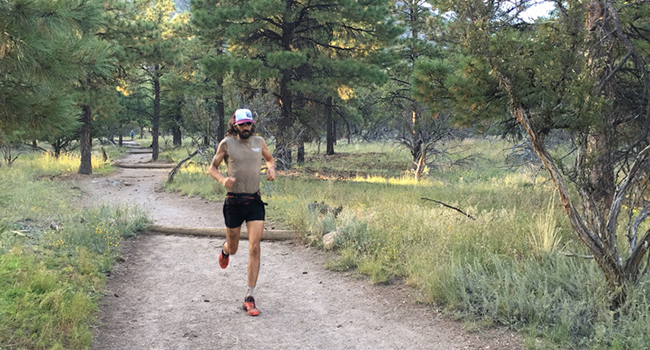Running 800 miles may seem like insanity to some people, but Michael Versteeg knew he’d get around to trying it one day.
“The Arizona Trail, I mean even before I started running, had always been a bucket-list item of mine,” Versteeg said.
That day has arrived as the 31-year-old Arizona native and ultra-runner gears up to attempt to complete the entire Arizona Trail in the fastest known time.
The Arizona Trail stretches from the border with Utah all the way down the state to the border with Mexico. Versteeg can expect to see a multitude of landscapes and some of the best terrain the state has to offer, according to Matthew Nelson, executive director of the Arizona Trail Association, a local, non-profit organization tasked with maintaining, promoting and protecting the trail.
“It goes through some of the most diverse terrain in the West, some say even the world,” Nelson said. “It sees some of the most unknown and lesser appreciated, but some of the most incredible, parts of our state.”
Nelson specifically mentioned the Mogollon Rim, Colorado Plateau, and Grand Canyon as major locations the Arizona Trail passes through. It also passes through a wide range of elevations from more than 9,000 feet on the Kaibab Plateau to just 1,600 feet near the Gila River.
Rob Trepa, 42, who completed the Arizona Trail in September 2015, said the experience was unique.
“It’s a totally different animal,” Trepa said. “It was pretty surreal. It took me 25 days and in some ways it took forever, but in other ways it was very quick.”
Trailblazing
Quickness will be the name of the game when Versteeg sets out. The fastest known time is 21 days, 14 hours, 16 minutes, set by Adam Bradley, 44, in 2011. Nelson said he’s seen a few people attempt to break the record over the years, but many, like Trepa, don’t realize what they’re in for.
“His record has been attempted by I can think of six people,” Nelson said. “Very qualified, very strong, ultra-endurance athletes, and none of them have come even close.”
“It’s tougher than you think,” Trepa said. “I thought we were going to crush it. I thought it was going to be no problem, but it turned into a totally different beast from day one.”
Trepa started out in this endeavor with a partner, Brett Foote. However, Foote left about a week into the trip and Trepa was left to finish alone. That freed him up to try and get back to the pace he wanted, but it didn’t work out the way he hoped.
“I really tried to put in as many miles as I could,” Trepa said. “With Brett, it was just 26 miles a day, and then after he left, I was able to get up to 32 miles a day. Going in, I wanted to do 50 or 60 miles a day.”
Versteeg also hopes to to run more than 50 miles a day, which he believes should put him in good position to break the record. But though the fastest known time would be an achievement, it’s not going to make or break his experience on the trail.
“I’m more concerned about just hitting my own goals,” Versteeg said. “It’s interesting and people like that story of going for that, which I will be excited to be able to say I’ve done that if it goes well and I’m able to complete it. But I’m coming at it from a personal place of setting my own goals and trying to achieve those, instead of the competitive side of things.”
Trepa agreed that, while getting the fastest known time would’ve been great, he wasn’t going to abandon the trail once it became out of reach.
“It was more than the fastest known time, although that was an objective,” Trepa said. “I had to make the call. Do I continue even though I wasn’t going to make the time? For me it was yes.”
Training
Versteeg is no stranger to long-distance running. He finished first in the inaugural Flagstaff to Grand Canyon Stagecoach Line 100-mile race in 2013, a race that takes place on a section of the Arizona Trail. So far in 2016, he’s finished first in the Black Canyon Ultras 60K in Mayer in February, the Whiskey Basin Trail Runs 88K in Prescott in April, and the Silverton Alpine Marathon in Silverton, Colorado in August. But even with those races under his belt, Versteeg isn’t going into to the Arizona Trail with any arrogance.
“I don’t know if I can do this,” Versteeg said. “This is uncharted territory for me.”
But Versteeg doesn’t seem too worried about keeping a regimented training schedule. When he does, he’s not even concerned with the specifics.
“I haven’t necessarily been worried about the mileage or especially speed,” Versteeg said. “I haven’t been doing any sort of speed training.”
Instead, his training comes down to something simple.
“The one thing I can say that I’ve been doing is just really long days on my feet,” Versteeg said.
That doesn’t necessarily have to be out on a trail either. Versteeg said that being on his feet all day working at his custom carpentry business is just as good.
Trepa had added extra weight to his training before his attempt.
“A lot of people can run, but when you put 30, 40 pounds on day after day after day, it’s tough.”
Versteeg also hopes to have a crew, or as he called it, “a mobile aid station,” that will meet up with him wherever there is easy access to the trail to provide him with food, charging stations for his phone and GPS and a place to sleep.
As far as who might show up at each of those stops, Versteeg mentioned that it would be great to see his family, which he said is excited about what he’s doing.
“I hope to see my aunt and uncle and maybe even my mom out there,” Versteeg said. “They’re all super supportive and really into it.”
The Arizona Trail Association also provides a number of online resources for anyone looking to plan an attempt of their own. These include maps, mileages, places to find water and towns along the way where you can get supplies.
While preparation is key to an undertaking such as this, both Nelson and Trepa stressed that the Arizona Trail is one of the hardest long-distance trails around. No matter how much one plans, the trail is always ready to offer up another stumbling block.
“It goes through such extreme climates,” Nelson said. “It’s harder than trails that are three times the distance because you have so many highs as far as temperature goes and so many lows as far as temperature. Lack of water resources, huge distance between towns makes it a pretty amazing remote wilderness experience.”
Added Trepa: “There are sections of the trail that, in September and October, are overgrown. You have to do a lot of clearing the trail and bushwhacking. I did take a couple wrong turns. I’d run out of water. That was probably my number one concern. I’d run into mountain lions; that was a big concern. There was something different every day.”
Though Versteeg admits he doesn’t know if he can succeed, he has faith in his physical and mental ability. It’s the mental side of things he believes can be even more important than the physical side.
“A lot of these type of projects really come down to mental fortitude, and if you’re able to push through those really, really dark moments and come out the other side,” Versteeg said.
Transforming experience
For many people, taking the time off necessary to complete the Arizona Trail in one go isn’t feasible. That’s why Nelson said he sees a common theme that runs through a lot of Arizona Trail thru-hikers.
“For a lot of people, a long-distance trip on the Arizona Trail marks a transition in life,” Nelson said. “It’s people that have decided that they want a change in their life and they want to dedicate the time to get out there.”
Versteeg said it is the right time in his life to make this attempt.
“I have a lot of things in my life right now that I’m looking forward to this project helping me with, so it’s definitely come along at the right point for me,” Versteeg said. “I think I’m going to hit some really dark places that I didn’t know existed, both physically, mentally and emotionally, and I’m looking forward to that in a weird way. I’m looking forward to healing and growing.”
Nelson said everyone he’s talked to who has thru-hiked the Arizona Trail has said they felt transformed by the experience. For him, there’s a magic to the Arizona Trail that will leave a lasting mark on those who tackle its entirety.
“You’re never the same ever again,” Nelson said. “The more time you spend out in nature and watching the sunrise and the sunset, and looking for water sources, and just being deeply immersed in nature, it has a pretty profound effect on people.”
Trepa agreed there’s a lot to be gained from the experience.
“You can find a lot of meaning, and I think you find self-worth from within,” Trepa said.
Even the initial hardships that the trail throws at you can eventually become inspirational once you accept them and learn how to deal with them.
“You cope and then you thrive,” Trepa said. “It took a couple of days maybe by myself where it was like, well this section looks prehistoric and totally dangerous and I’m here by myself. But after you climb up and to it, you felt safer than you would anywhere in the world.”
Taking on a cause
Personal goals aren’t the only reason Versteeg decided to attempt the Arizona Trail. He also wanted to be able to give back in some way.
“I feel like for whatever reason, running has become almost synonymous with fundraising,” Versteeg said. “I feel like it would be a little bit of a waste if I didn’t take this opportunity to raise funds for something greater than my personal interests.”
So Versteeg set up a GoFundMe page and began accepting donations. The cause he’s chosen to support is Save the Confluence. The movement hopes to stop proposed tourism development at the confluence, or meeting point, of the Colorado and Little Colorado Rivers. The site is located on the eastern edge of the Grand Canyon.
“By running this, doing this silly running project of my own, hopefully I can create a greater purpose for that and contribute to the movement,” Versteeg said.
By Michael Boylan, Cronkite News




